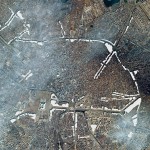+ urban planning project, Bucharest
The historical boulevard Calea Moşilor which developed a lot in the ‘80s was selected as a studycase. The proposed strategy develops the principles of an intervention area (a new public space), an opening of the concrete curtain through a series of public functions and a regulation system to foster investments and the improvement of life in the area. The project defines three types of areas: an intervention one, to cover the space left free behind the rows of blocks and which can be changed into a system of public places through a series of modernizing actions managed by the administration; a protection area which coincides, mostly, with the protected historical area; between them, a buffer zone, made of the old streets, the lots and the private buildings whose development needs to comply with urban planning regulations. Those will contribute to save the protection area through attracting those interested to build to the buffer zone, and investments (private and public) in commercial spaces, community services, garages etc. will contribute to improve the quality of the public space and the life of the locals.
Project authors: Zeppelin Association, Point4, Archis Interventions, Hackenbroich Architekten, in cooperation with ATU, Space Syntax România, StudioBASAR, Platforma 9.1.
Supported by: Erste Stiftung, Administration of National Cultural Heritage, Union of Romanian Architects, Goethe Institut. Partner: Roca.



